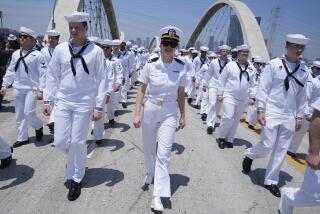Students Tour Navy Frigate : Education: Santa Ana seventh-graders got firsthand knowledge about the Gulf crisis aboard the just-returned ship.
- Share via
LONG BEACH — They flooded Marine combat troops and Navy crewmen in the Persian Gulf with more than 1,000 letters.
Then, on a visit to Orange County, Vice President Dan Quayle personally praised them for their patriotism and their concern about the Mideast situation.
And on Monday, students at Douglas MacArthur Fundamental Intermediate School in Santa Ana received a firsthand account of the crisis when they toured the guided missile frigate Vandegrift, which recently returned from the Persian Gulf to the Long Beach Naval Station. For three hours, 60 seventh-graders explored the ship, climbing steep ladders to view everything from its arsenal, sonar and radar controls to the exercise room and mess hall.
“When you hear about it on the news, they don’t tell you who they are and what they are doing,” Sarahu Gerkin, 12, said after the visit. “Here, you see what they go through. . . . You know these people now.”
Earlier this month, Navy Cmdr. Chris Johnson, the captain of the ship, visited the school with several crewmen to talk to the students about the Gulf crisis. After that, the school adopted three Navy ships, including the Vandegrift, the David Ray and the Antietam, which is scheduled to return from the Gulf in January.
The 453-foot Vandegrift had been in the Persian Gulf for three months when Iraq invaded Kuwait on Aug. 2. Because of the invasion, the ship’s tour was extended a month. On Oct. 12, it returned to Long Beach, where it will be dry-docked early next month.
The invasion has been woven into the Santa Ana school’s geography, language and social studies classes. For example, the letter-writing was used to help students hone their writing and grammatical skills.
The students got a huge response from the Marines. So far, they have received 650 replies from the troops, and some students got souvenirs, including Saudi Arabian currency, desert sand and candy wrappers.
Before Monday’s tour, the students all had to take a test to show they were “intelligent participants,” teacher Samme Nemecek said. The test included questions on the Vandegrift’s speed, launch date and weapons systems.
Still, most students were surprised at the size of the ship’s sophisticated Navy weaponry, including the MK-13 missile launcher, which thrusts 2,320 pounds with each launch.
“How many of you have seen a model rocket go off?” asked Gunnery Mate Steve Manahan, who led one tour. “Imagine one that weighs 1,600 times that going off. It’s like the Fourth of July every time one goes off.”
On the top deck of the ship, Manahan showed the students an MK-75 76-millimeter gun that can fire up to 8 miles and the Sea Whiz Close In Weapons System, which can fire 3,000 rounds a minute.
“See that? Does that look like Star Wars?” Manahan said, pointing at the canister-shaped gun. “This is our own R2D2.”
But operating the equipment wasn’t the difficult part, the students learned. Living away from home and without life’s little conveniences was.
“When we’re out in the ocean, we don’t have a 7-Eleven to go to and get Slurpies,” Manahan said.
Even less appealing to the students were the water rationing (25 gallons per person per day) and the steep stairs between decks. Most of all, it was the isolation that made some students admire the crew’s stamina at sea.
“They have to go out there so far away and stay on that ship,” said Cristi Roberts, 12. “The place is so small.”
But the tour, she said, helped bring the crisis home. The sheer magnitude of the ship’s weaponry made the prospect of war more frightening.
“When you are involved in it, it’s real,” she said. “It seems so real to you.”
More to Read
Sign up for Essential California
The most important California stories and recommendations in your inbox every morning.
You may occasionally receive promotional content from the Los Angeles Times.












